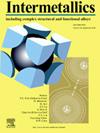Design of novel structural eutectic high entropy alloys (EHEAs) containing high-temperature resistant alloying elements
IF 4.3
2区 材料科学
Q2 CHEMISTRY, PHYSICAL
引用次数: 0
Abstract
This article employs the “Simple Mixing Enthalpy Method” to add high-temperature alloying elements Mo/V and Nb to the Fe-Co-Cr-Ni-based alloy system, and utilizes a model of the relationship between elements and phase structures. Finally, EHEAs are successfully designed with the help of phase diagrams, namely FeCoNi2.0Cr1.2Mo0.2Nb0.63 (Mo0.2Nb0.63) and FeCoNi2.0Cr1.2V0.2Nb0.68 (V0.2Nb0.68). In EHEAs, a typical fully eutectic microstructure is observed, consisting of alternating FCC (face-centered cubic) and HCP (hexagonal close-packed) phases. Evaluation of mechanical performance indicators reveals that nano-hardness and elastic modulus increase from the FCC phase to the HCP phase, while the hardness and elastic modulus of the eutectic phase originate from modulation of these two phases. Meanwhile, the microhardness of both alloy systems increases linearly with increasing Nb content. In addition, EHEAs exhibit high strength and ductility but with differences attributed to the significant influence of Mo and V elements on eutectic phase spacing and phase size. Different phase interface types and strain gradients during deformation affect the mechanical properties. This study tests the high-temperature compression performance and fracture morphology of novel high-entropy alloys, paving the way for subsequent research on high-temperature performance.
设计含有耐高温合金元素的新型结构共晶高熵合金 (EHEAs)
本文采用 "简单混合焓法 "在铁-铜-铬-镍基合金体系中添加高温合金元素 Mo/V 和 Nb,并利用元素与相结构之间的关系模型。最后,在相图的帮助下成功设计出 EHEAs,即 FeCoNi2.0Cr1.2Mo0.2Nb0.63 (Mo0.2Nb0.63) 和 FeCoNi2.0Cr1.2V0.2Nb0.68 (V0.2Nb0.68)。在 EHEAs 中,观察到典型的全共晶微观结构,由交替的 FCC(面心立方)和 HCP(六方紧密堆积)相组成。对力学性能指标的评估显示,纳米硬度和弹性模量从 FCC 相增加到 HCP 相,而共晶相的硬度和弹性模量则源自这两种相的调制。同时,这两种合金体系的显微硬度随着铌含量的增加而线性增加。此外,EHEAs 还表现出较高的强度和延展性,但由于 Mo 和 V 元素对共晶相间距和相尺寸的显著影响,两者之间存在差异。不同的相界面类型和变形过程中的应变梯度会影响机械性能。本研究测试了新型高熵合金的高温压缩性能和断裂形态,为后续的高温性能研究铺平了道路。
本文章由计算机程序翻译,如有差异,请以英文原文为准。
求助全文
约1分钟内获得全文
求助全文
来源期刊

Intermetallics
工程技术-材料科学:综合
CiteScore
7.80
自引率
9.10%
发文量
291
审稿时长
37 days
期刊介绍:
This journal is a platform for publishing innovative research and overviews for advancing our understanding of the structure, property, and functionality of complex metallic alloys, including intermetallics, metallic glasses, and high entropy alloys.
The journal reports the science and engineering of metallic materials in the following aspects:
Theories and experiments which address the relationship between property and structure in all length scales.
Physical modeling and numerical simulations which provide a comprehensive understanding of experimental observations.
Stimulated methodologies to characterize the structure and chemistry of materials that correlate the properties.
Technological applications resulting from the understanding of property-structure relationship in materials.
Novel and cutting-edge results warranting rapid communication.
The journal also publishes special issues on selected topics and overviews by invitation only.
 求助内容:
求助内容: 应助结果提醒方式:
应助结果提醒方式:


